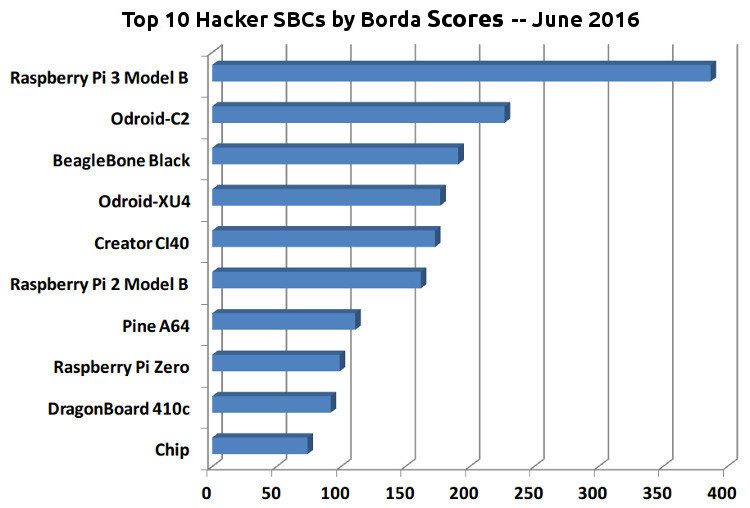Two years ago, the Raspberry Pi seemed as if it might be eclipsed by a growing number of open-spec single board computer projects with faster processors, Android support, and more extensive features. But then the Raspberry Pi reestablished its lead in two major great leaps forward.
In early 2015, the Raspberry Pi Foundation released a quad-core, Cortex-A7 based Raspberry Pi 2, and then followed up a year later with a 64-bit, quad-core Cortex-A53 Raspberry Pi 3 with onboard wireless. The project wisely made these great leaps forward without messing much with the basic form-factor, port layouts, expansion connector, or software, all while keeping the same $35 price.
That dominance was reflected in the newly published results from a survey of community-backed board preferences taken earlier this month by HackerBoards.com. The survey asked readers to choose their favorite three Linux- or Android-based open-spec SBCs from a list of 81. Just as the Raspberry Pi 2 won last year’s 53-board survey, the Raspberry Pi 3 similarly blew away the competition in 2016.
Once again, an Odroid board and the BeagleBone Black filled the next two slots, although this time it was the Odroid-C2 in second and the BeagleBone third. Otherwise, the top 10 list looked considerably different from last year’s results. For example, only three of the top 10 most popular SBCs were around a year ago: the BeagleBone, RPi 2, and DragonBoard 410c, and only the BeagleBone was on our 2014 top 10 list. Four of this year’s top-10 contenders were new, 64-bit ARMv8 boards.
The following list shows the top 10 out of 81 boards, which were all ranked using Borda Count scoring in which second and third favorite choices were also factored in. To make the list, the SBCs had to run Linux or Android, cost less than $200, and ship no later than June 2016. They also needed to meet some basic requirements for open source compliance and community support.

Open source support, low price influence buyers
Low priced boards with Raspberry Pi interfaces dominate the top half of the 81-board list. The 40-pin expansion interface has significantly broadened the Raspberry Pi community, even while reducing the necessity of owning a Raspberry Pi in order to gain access to that ecosystem. Among Linux/Android hacker boards, it has become more popular than an Arduino shield compatible interface, although those are in abundance as well. SeeedStudio Grove and MikroElektronika MikroBus Click interfaces are also found on many of these boards.
One of the Pi-compatible SBCs is Hardkernel’s $40 second-place Odroid-C2, which arrived around the same time as the $35 Raspberry Pi 3, and with similar features such as quad-core, 64-bit processors. The Odroid-C2 has the faster chip, but the cheaper RPi 3 also throws in WiFi and Bluetooth. Here, the Raspberry Pi is staying ahead of a general trend toward onboard, rather than, optional wireless.
Although low pricing was clearly popular here, with the $15 Pine A64, $9-and-up Chip, and $5-and-up Raspberry Pi Zero all making the top 10 list, some relatively pricey boards such as the Creator Ci40, Odroid-XU4, and DragonBoard 410c made the list too. When survey takers were asked to rank buying criteria, low price dropped in rank compared to last year. Other responses to questions about buying criteria remained largely consistent from last year, with home automation, for example, continuing to lead the list of intended applications.
It would appear that many potential buyers don’t see much difference between, say $20 and $35, especially when shipping is taken into account. The real impact for products such as the dirt-cheap Raspberry Pi Zero is likely going to be felt in more commercial products sold in small runs, or in hobbyist/maker projects in which CPU clusters and numerous IoT sensor boards are required. If you’re a weekend hobbyist looking to automate your sprinkler system with a single SBC, other issues are likely more important.
There seems to be growing resistance to irresistibly priced SBCs from certain Shenzhen-based projects. The $10 Orange Pi One and $12 Orange Pi Lite, both sporting the quad-core Allwinner H3, were ranked 28th and 31st, respectively. Of the five FriendlyARM NanoPi boards, several of which had similar cut-rate pricing, the highest ranked model was the $35, 64-bit NanoPi-M3, which came in 41st.
Buyers seem to be looking more closely at open source software support, which once again was the leading buying criteria in the survey. With so many cheap, capable SBCs to choose from, people can afford to be picky and choose the projects that offer timely firmware updates and solid community resources. How else to explain the surprising popularity of the 19th ranked Wandboard, an aging, fairly high-priced SBC with strong software support.
Another example where community and software support makes up for fairly low price/performance is the venerable, third-place BeagleBone Black. If you combined its score with the currently available clones — the BeagleBone Green, BeagleBone Green Wireless, and MarsBoard AM335x — this $48, Cortex-A8 based SBC would be neck and neck with the Odroid-C2. And more BeagleBone clones are on their way.
Of course, if you combined the Raspberry Pi 3 with the very similar RPi 2, now in 6th place, and the less similar, $5-and-up RPi Zero, now in 8th, you’d get an even more impressive total. It’s hard to imagine that a Raspberry Pi model won’t be the people’s choice in 2017, as well. Then again, judging from the amazing price/performance improvements that have occurred in the SBC market in 2016, a lot can happen in a year.


